Zoom in on Diplodocus!
Take an up-close look at the world's most well-knowndinosaurs. Learn about dinosaur heads, teeth, tails, skin, and more!Beginning readers will be fascinated as they read about the creatures that once roamed the earth. These easy-to-read books are filled with interesting facts and exciting illustrations.Allan A. De Fina, PhD, Series Literacy Consultant
Dean, College of Education/Professor of Literacy Education
New Jersey City University
Past President of the New Jersey Reading Association
Written by one of the leading dinosaur experts, Zoom In on Dinosaurs! is an exciting series for kids that is packed with facts!Philip J. Currie, PhD, Series Science Consultant
Department of Biological Sciences
University of Alberta
Edmonton, Alberta, Canada
About the Author
Peter Dodson, PhD, is a professor of veterinary anatomy and paleontology at the University of Pennsylvania in Philadelphia. For forty years he has collected and studied dinosaurs in Canada, the United States, India, Madagascar, Argentina, and China.
With his students he has described four new dinosaurs, most recently Auroraceratops from China. 
dinosaur (DY noh sor)Reptiles that lived from about 230 million years ago to 65 million years ago. They had a special kind of hip and long legs.
fernA kind of plant with lacy leaves.
fossils (FAH sulz)Parts or marks of living things
from long ago.
iguana (ih GWAH nuh)A plant-eating lizard.
mammalAn animal that can grow fur or hair and make milk for its young.
predator (PREH duh tur)An animal that hunts and kills other animals for food.
pterosaurs (TAIR uh sorz)Reptiles that flew.
pterosaurs (TAIR uh sorz)Reptiles that flew.
They were not dinosaurs. Allosaurus [AL uh SOR us] Amargasaurus [uh MAHR guh SOR us] Apatosaurus [uh PA tuh SOR us] Dicraeosaurus [dye KRAY uh SOR us] Diplodocus [dih PLAH duh kuss] Seismosaurus [SYZ muh SOR us] Stegosaurus [STEH guh SOR us]
Diplodocus was a huge
dinosaur with a very long neck. The dinosaur stretched 90 feet from head to tail. That is about as long as three school buses.

Diplodocus weighed 12 tons.
 Diplodocus
Diplodocus had a neck that was 26 feet long.
 Diplodocus
Diplodocus had a neck that was 26 feet long.
That is four times as long as a giraffe's neck!  With its long neck, Diplodocus could reach many plants without walking far.
With its long neck, Diplodocus could reach many plants without walking far.
Diplodocus had a tail that was 45 feet long. It ended in a thin tip.

Maybe
Diplodocus snapped the end of its tail like a whip to scare away predators.
Diplodocus had tall, straight legs like an elephant's legs.
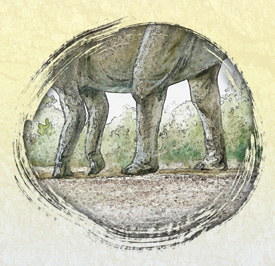 Diplodocus
Diplodocus walked slowly, looking for plants to eat.
It was too heavy to run. Groups of Diplodocus walked far during the year. 
Diplodocus had long, thin teeth, like pencils. They grew only in the front of its mouth.
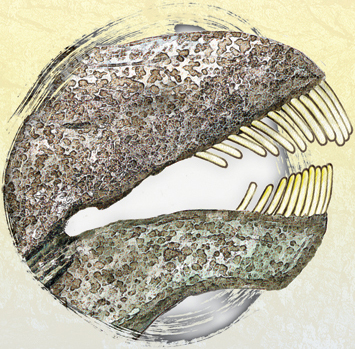
The teeth helped it eat plants, like
ferns.
 Diplodocus
Diplodocus stripped leaves from branches of trees.
It also ate soft plants that grew in the water.
Baby
Diplodocus hatched from large eggs.

The babies were about three feet long. They chewed piles of leaves. They grew very fast! By age ten, they were 30 feet long.
 Diplodocus
Diplodocus had skin like that of other reptiles.
 Diplodocus
Diplodocus had skin like that of other reptiles.
It looked like pebbles. 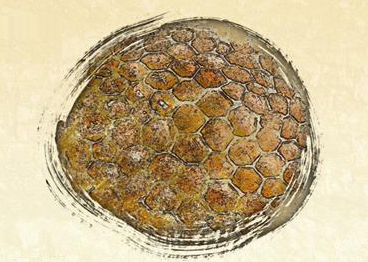 Diplodocus may have had soft spikes on its tail or over its backbone. Iguanas have skin like that. Maybe the long neck or tail had bright colors.
Diplodocus may have had soft spikes on its tail or over its backbone. Iguanas have skin like that. Maybe the long neck or tail had bright colors.  Perhaps there were stripes on the sides.
Perhaps there were stripes on the sides.
Diplodocus lived near lakes and rivers.
Diplodocus lived near lakes and rivers.
Tall trees grew close by.  Diplodocus also lived in open areas with low plants. There were ferns and other plants to eat.
Diplodocus also lived in open areas with low plants. There were ferns and other plants to eat.
Diplodocus lived with other large plant eaters, such as
Apatosaurus and
Stegosaurus. They stayed away from hungry meat eaters like
Allosaurus.

Small crocodiles, turtles, and frogs lived on the shores of rivers and ponds.
Little mammals climbed trees or lived in the ground for safety. Flying reptiles called pterosaurs flew in the skies.
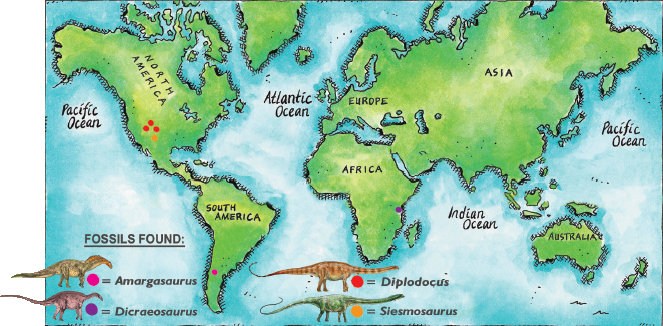
Many
fossils of
Diplodocus have been found. They show scientists that these dinosaurs lived in the western United States. Utah, Colorado, and Wyoming have the most
Diplodocus fossils.
Seismosaurus comes from New Mexico.
Dicraeosaurus comes from Africa.
Amargasaurus comes from South America.
Books Birch, Robin.

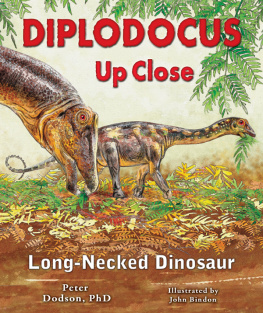
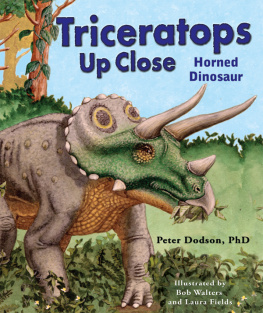
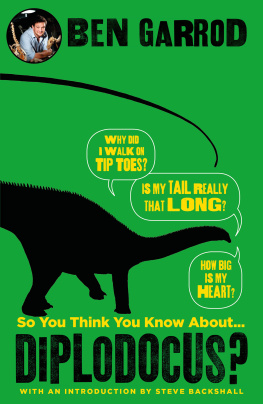
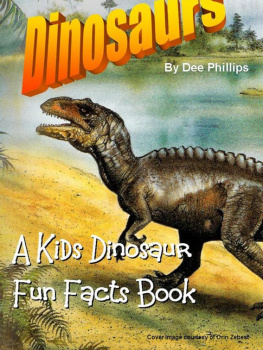

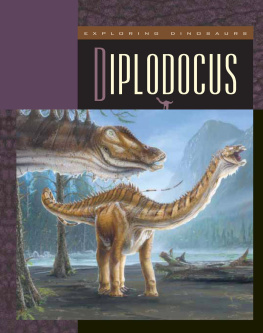
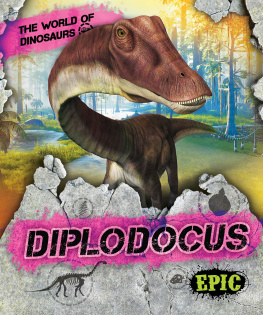
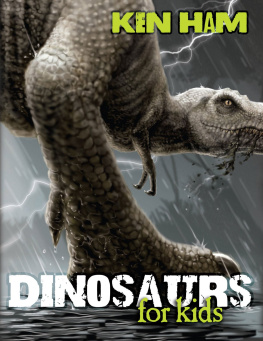
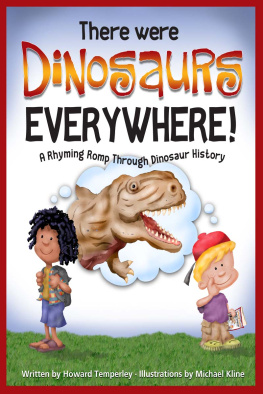


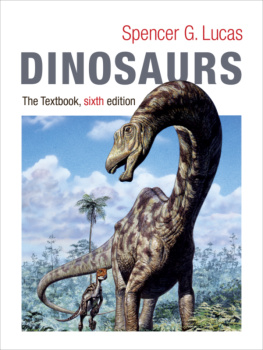

 Diplodocus weighed 12 tons.
Diplodocus weighed 12 tons.  Diplodocus had a neck that was 26 feet long.
Diplodocus had a neck that was 26 feet long.  With its long neck, Diplodocus could reach many plants without walking far.
With its long neck, Diplodocus could reach many plants without walking far. Maybe Diplodocus snapped the end of its tail like a whip to scare away predators. Diplodocus had tall, straight legs like an elephant's legs.
Maybe Diplodocus snapped the end of its tail like a whip to scare away predators. Diplodocus had tall, straight legs like an elephant's legs.  Diplodocus walked slowly, looking for plants to eat.
Diplodocus walked slowly, looking for plants to eat. 
 The teeth helped it eat plants, like ferns.
The teeth helped it eat plants, like ferns.  Diplodocus stripped leaves from branches of trees.
Diplodocus stripped leaves from branches of trees.  The babies were about three feet long. They chewed piles of leaves. They grew very fast! By age ten, they were 30 feet long.
The babies were about three feet long. They chewed piles of leaves. They grew very fast! By age ten, they were 30 feet long.  Diplodocus had skin like that of other reptiles.
Diplodocus had skin like that of other reptiles.  Diplodocus may have had soft spikes on its tail or over its backbone. Iguanas have skin like that. Maybe the long neck or tail had bright colors.
Diplodocus may have had soft spikes on its tail or over its backbone. Iguanas have skin like that. Maybe the long neck or tail had bright colors.  Perhaps there were stripes on the sides.
Perhaps there were stripes on the sides. Diplodocus also lived in open areas with low plants. There were ferns and other plants to eat.
Diplodocus also lived in open areas with low plants. There were ferns and other plants to eat. Small crocodiles, turtles, and frogs lived on the shores of rivers and ponds.
Small crocodiles, turtles, and frogs lived on the shores of rivers and ponds.  Many fossils of Diplodocus have been found. They show scientists that these dinosaurs lived in the western United States. Utah, Colorado, and Wyoming have the most Diplodocus fossils. Seismosaurus comes from New Mexico. Dicraeosaurus comes from Africa. Amargasaurus comes from South America. Books Birch, Robin.
Many fossils of Diplodocus have been found. They show scientists that these dinosaurs lived in the western United States. Utah, Colorado, and Wyoming have the most Diplodocus fossils. Seismosaurus comes from New Mexico. Dicraeosaurus comes from Africa. Amargasaurus comes from South America. Books Birch, Robin.